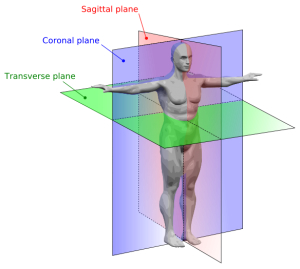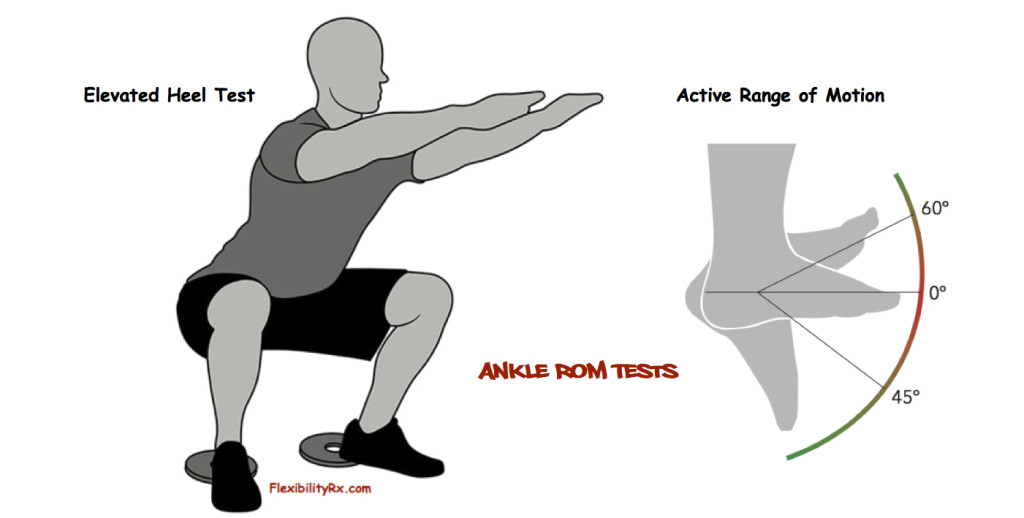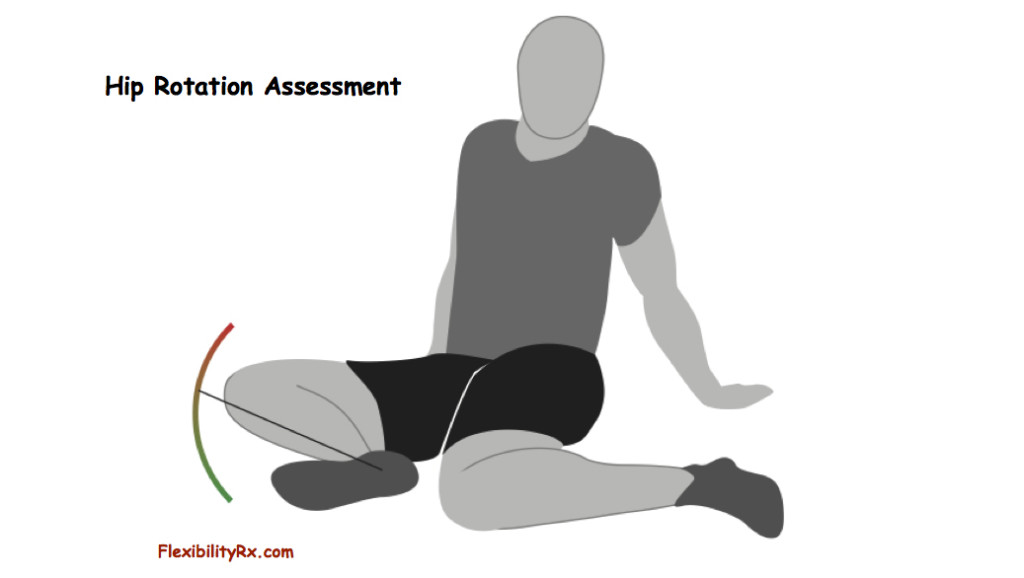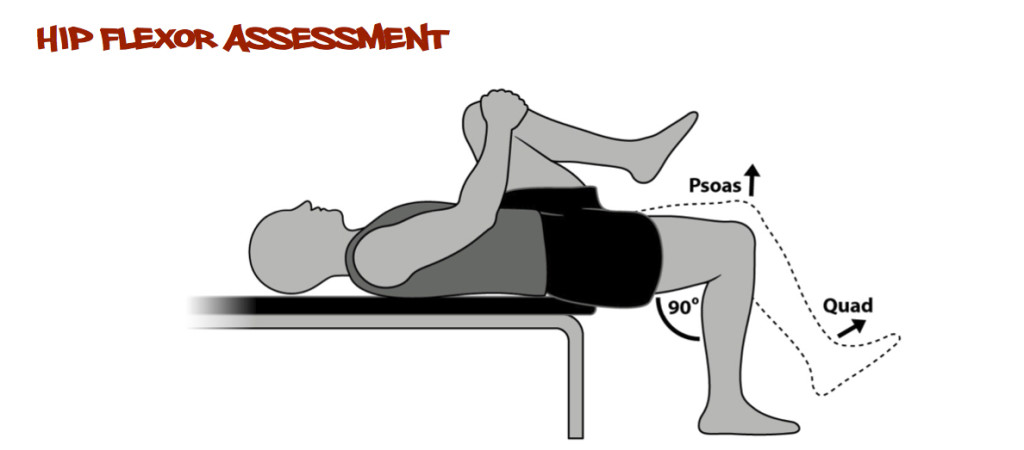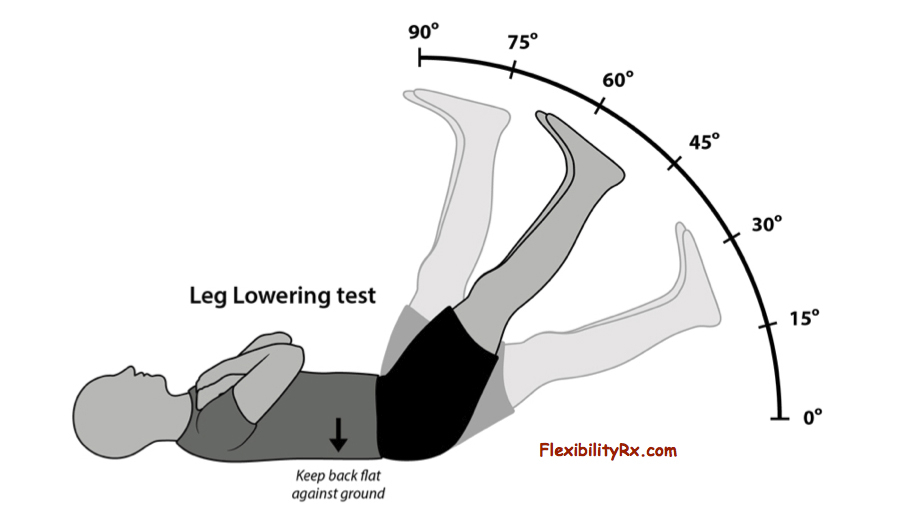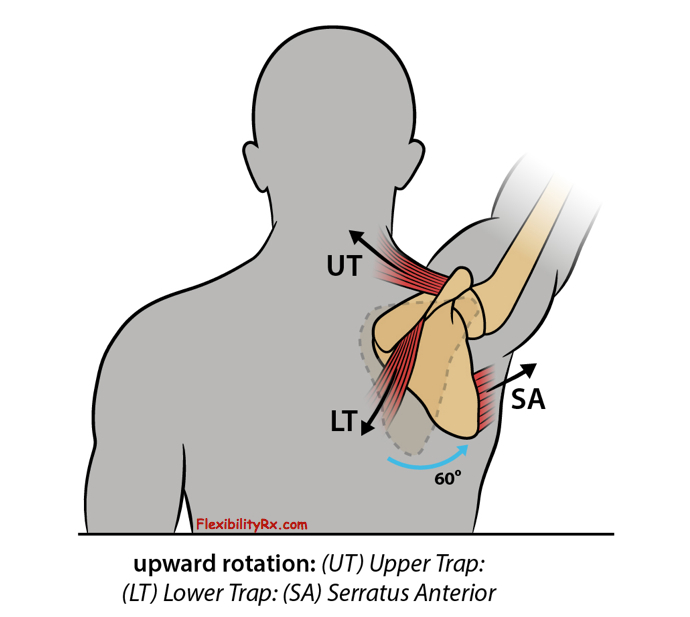ONLINE FITNESS ASSESSMENT
Online Fitness Assessment
The following series of tests do not measure strength but flexibility and stability. The ability to move well and perform fundamental movement patterns like the squat is called movement competency. Movement competency is a demonstration of good motor control with a balance of both core stability and flexibility at each joint.
Movement competency is the basis for strength development (strength capacity). An athlete that is training heavy deadlifts strictly using their low-back and hamstrings, instead of their glutes, is enforcing a movement dysfunction and not improving their fitness. They are performing the deadlift in the wrong way to compensate for their lack of movement competency.
Their ability to do the movement correctly (competency) is what will ultimately determine how much weight they can add to the movement and how strong they will get (capacity) without getting injured. Strength training – lifting weights in the gym – is about consistency. If an athlete struggles with the nine assessments below, their ability to train consistently and produce results will be diminished.
Flexibility + Stability + Motor Control = Movement Competency
An athlete that has both flexibility and stability can learn and practice motor control during functional movement patterns to develop movement competency.
Flexibility is, “Central nervous system control of a joint to move without influence.” This definition explains that a flexibility limitation is not always caused by a soft-tissue adhesion – a lack of stability can create tightness during movement – the brain often shuts down range of motion around a joint.
Poor core stability, for example, can limit both shoulder flexion and hip flexion. When the muscles around the spine do not provide adequate stability, muscle function and joint position will be compromised at the hip and shoulder.
Developmental movement patterns (crawling, lunging, squatting) are all core-to-extremity – the muscles of the core stabilize the trunk before arm and leg movement occur. This fixed point of the core, which provides a stable base for muscles to control the arms and legs is referred to as the ‘punctum fixum’.
Both flexibility and stability problems can interfere with the core’s ability to allow for effective transfer of movement in the lower body (squatting) and upper body (pushing/pressing).
Stability is, “Control in the presence of change.” When an athlete has the range of motion (flexibility) and control to resist undesired movements at each joint (stability) they can execute motor control during multi-joint movements like the squat, deadlifts, and shoulder press.
Joint-Centration
While core stability lays the foundation for arm and leg movements, the proper alignment of each joint is also dependent on a balance between flexibility and stability. The proper alignment of the ankles, knees, hips, low-back, thoracic spine, scapula, and arms is referred to as joint-centration. The joint is centered (centrated) in a neutral position that allows for the brain, muscles, and joint-itself to execute good movement patterns.
Joint centration during a shoulder press, for example, requires flexibility for hip extension, core stability to avoid arching of the low-back, and shoulder flexibility to support the arms overhead.
3D Stability for Movement in Three Planes
There are three planes in which movement occurs: the sagittal, frontal, and transverse planes.
Sagittal plane movements involve moving forward (running, lunging), pushing the hips back (deadlift, kettlebell swing). Frontal plane movements are side-to-side, while transverse plane movements involve rotation.
Anterior Core Stability: Anterior core stability is needed for sagittal plane movements to prevent hyper-extension of the low back. The abdominals play an important role in stabilizing the hips and low-back as well as fixing the ribcage down during overhead lifts. The abdominals contribute to intra-abdominal pressure for core stability.
Lateral Stability: Lateral stability is also important for sagittal plane movements to stabilize the hips and knees during running, lunging, and single-leg exercises. The glutes and external hip rotators play an important role in lumbo-pelvic stability.
Rotary Stability: Rotary stability is needed to prevent rotation – especially at the low-back. The abdominal obliques help control rotation and are engaged in movements like the rotary band hold, bird-dog, plank-roll, chop and lift, and landmines. Single arm and leg exercises also require rotary stability.
The Joint-By-Joint Approach
The joint-by-joint approach is a framework for understanding the interplay of mobility and stability at each particular joint. Developed by Mike Boyle and Gray Cook, this approach states that joints alternate between requiring more mobility or stability.
This framework is useful for flexibility and stability training – as the ankles, hips, thoracic spine, and arms require flexibility and the knees, low-back, and scapula require stability.
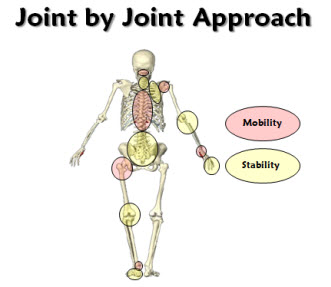
Gray Cook emphasizes the importance of mobility before stability. The first step in developing good motor control is removing any flexibility limitation at the ankles, hips, thoracic spine, and arms.
Here is how the joint-by-joint approach correlates to the 9 tests
Ankles: Improve ankle range of motion (test #1)
Knees: Improve glute function for knee stability (test #2) and hip rotation for knee tracking (test #3).
Hips: Improve hip rotation (test #3). Improve hip extension by removing any hip flexor tightness (test #4), and by restoring glute function (test #2).
Low-Back: Improve hip rotation (test #3), hip extension, and then train anterior core stability (test #6). The hip hinge pattern (test #9) helps with hip motor control to unload the low-back.
Thoracic Spine: The thoracic spine requires mobility – athletes that are stuck in flexion – need to mobilize the thoracic spine for extension. Thoracic extension is correlated with anterior core stability and shoulder flexion. Test #7 is an assessment of thoracic extension and shoulder flexion. Anterior core stability (test #6) is required during the arm movement of the test to fix the ribcage down.
Scapula: The shoulder blade requires stability for the arm to have mobility. Dynamic scapular stability (good shoulder blade movement) is largely a function of the ability to upwardly rotate the shoulder blade during shoulder flexion (test #8).
Arms: The gleno-humeral joint (shoulder) is assessed in test #7 (shoulder flexion). Anterior core stability, thoracic extension, and scapular stability are all required for good arm movement.
While some joints require more mobility (ankles, thoracic spine) and some joints require more stability (knees, low-back) – the function of each joint is determined not only by it’s own function – but also by the function of the joint above or below. Poor ankle range of motion for example can cause the knees to cave in during squats (instability).
In Summary
When a joint has both normal range of motion and stability during movement an athlete has a basis of movement competency. Movement competency is what allows for strength capacity – the ability to add weight and difficulty to movements.
This fitness assessment is an excellent measure of your ability to move well and your readiness to enter a functional fitness program.
The FREE Guide, “Joint-by-Joint Approach to Flexibility & Stability Training” is downloadable by providing your email at the bottom of the page. Detailed exercises are provided to help you pass each test.
#1: Ankle Range of Motion
Ankle flexibility is crucial to running, lunging, and squatting. Limited ankle range of motion can impair glute function – robbing the hips of their power – during certain athletic movements. An athlete that has poor ankle flexibility will have achieving full squat depth, keeping the knees out, and maintaining an upright torso.
When range of motion is limited, muscles will not be able to perform their stabilizing roles effectively. Restricted ankle ROM often causes problems at the knees and hips. A lack of mobility decreases stability at other joints.
Instructions: Note the following five points of performance for the squat before performing an air squat.If elevating your heels helps with any of the points of performance you will want to work on your ankle flexibility.
Points of Performance
#1: Weight on Heels
#2: Hips Below Parallel
#3: Knees Out
#4: Upright Torso
#5: Neutral Lumbar Curve
In addition to assessing the effect of ankle ROM on the squat, perform the active range of motion assessment (ankle up/down) noting your range – red indicates lack of flexibility).
#2: Glute Function (Knee Tracking & Hip Extension)
Movement is stabilized by the core and driven by the hips. The hips are the powerhouse of all athletic movement. The glutes perform a variety of different functions including hip external rotation and hip extension.
Knee Tracking: During a single-leg stance the glute max and external hip rotators stabilize the knee. The glute max stabilizes the knee through the IT-band and the external hip rotators control the femur. This stabilizing function prevents the knee from collapsing inward during running, lunging, and pistol squats.
Instructions: To assess knee tracking you will perform a pistol box squat with a 10lb plate held in front as a counterweight (not pictured). Standing on one leg in front of a box slowly lower and note your ability to control the descent and keep the knee from caving in. Observing your knee position during lunging and split squats is another good way to monitor knee tracking.
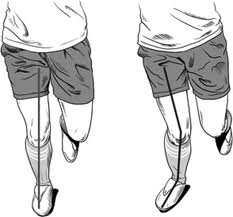
Hip Extension: The glute max is the primary hip extensor and is assisted by the hamstrings to lock out the hips during the completion of the deadlift and ascending part of the squat. Many athletes have inhibited glutes and overactive hamstrings.
Anterior Femoral Glide Syndrome
The illustration below (taken from Shirley Sahrmann’s “Movement Impairment Syndromes”) shows a dysfunctional pattern called AFGS. Graphic A shows the glute max extending the hip and graphic B shows the hamstring extending the hip. While the glute max and hamstrings work together to extend the hip, when the glute max is inhibited, the hamstrings become the dominant hip extensor.
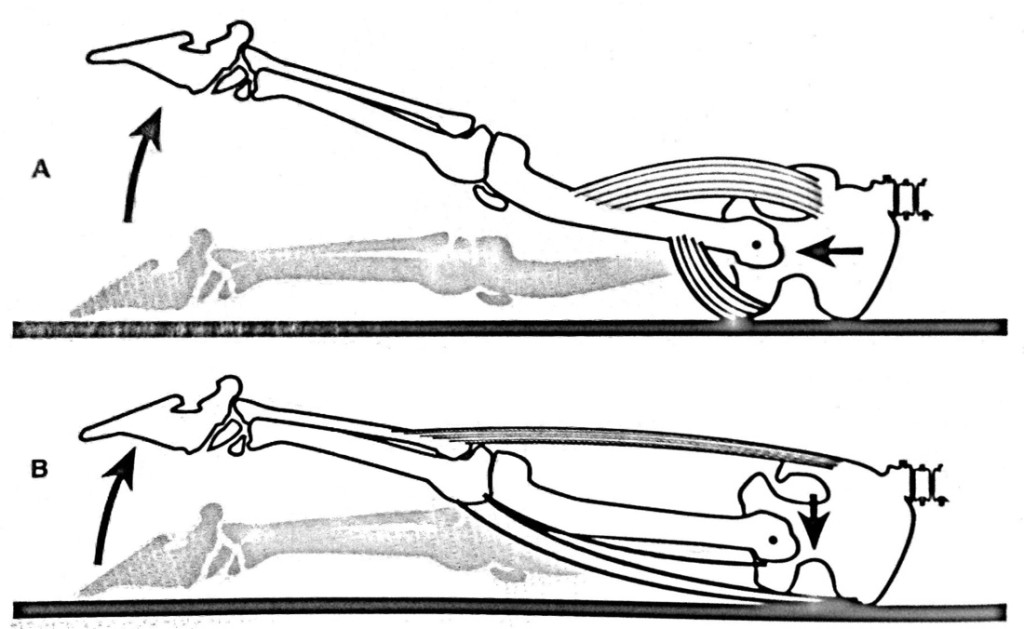
The arrows show the effect of each muscle on the head of the femur. When the hamstrings extend the hip without the full contribution of the glute max the head of the femur glides anteriorly in the hip joint (down arrow). The glute max is closer to the joint and its contraction is needed for the femur to glide posteriorly in the hip joint (left pointing arrow).
Hamstring dominance and glute inhibition destabilizes the head of the femur and prevents full hip range of motion. This anterior glide of the femur can also impair hip internal rotation.
Rather than stretching the hamstrings, it is more important to activate the glutes while relaxing the hamstrings during exercises like the single leg glute-bridge.

Instructions: To assess hip extension lie on your back with your knees bent to ninety degrees. Slowly lift your hips off the floor using your glutes. The free leg will remain bent at ninety degrees as it lifts while you raise the hips.
The assessment is for the support leg – note if your hamstrings cramp or if your low-back is doing most of the work. Perform a few repetitions focusing on using your glutes and relaxing your hamstrings and low-back.
Since the hamstrings are shortened (support leg is bent to ninety degrees) when they overcontract to compensate for poor glute activation they will often cramp.
Assess both sides.
#3: Hip Rotation (Internal & External)
The hips like the shoulders require flexion, extension, and rotation (internal and external). Hip rotation is dependent on joint-capsule flexibility – fifty percent of range of motion is in the joint itself. Both tight and overactive muscles can restrict hip rotation. Poor anterior core stability and lateral stability can cause muscles to be overactive and prevent hip rotation. In the case of poor stability, the issue may not be flexibility limitation but a range of motion limitation as compensation.
After assessing hip rotation, a good strategy is to apply joint-capsule mobilizations and assess bot the front and side plank to determine your level of stability.
Restricted internal rotation is correlated with poor lateral stability
Restricted external rotation is correlated with poor anterior core stability
Hip Internal Rotation is important for the health of the knees and low-back. Internal rotation is needed during the hip flexion phase of the squat and during hip extension while running or lunging. Athletes that have low-back pain or a clicking or popping in the hip often have poor internal rotation. A lack of hip internal rotation decreases proprioception (body awareness) and decreases hip stability and glute function.
Hip External Rotation is important for good knee tracking and to support positions that require hip flexion and external rotation like the bottom position of the squat. Tight glutes and external hip rotators often limit hip rotation along with tightness of the hip joint capsule.
Instructions: Take a seat on the ground with both knees bent about ninety degrees. In a windshield wiper motion, keeping the knees bent at ninety degrees rotate your knees back and forth allowing the knees to touch the floor. In the illustration below the right hip is in external rotation and the left hip in internal rotation.
If the right hip does not touch the floor external rotation on that side is limited. If the left hip does not touch the floor and your have trouble sitting with the hips in a neutral position, internal rotation is limited.
#4: Hip Extension
Hip extension is needed for most athletic movements. Hip extension is a function of the glutes and hamstrings. Deadlifts, kettlebell swings, squats, and box-jumps all require hip extension to complete the lockout position of the movement as the hips go from flexion to extension in standing.
The glute max is often inhibited by tight hip flexors which causes the hamstrings and low-back to overwork. Improving hip extension requires a combination of stretching tight hip-flexors and activating the glutes.
The two main hip flexors include the superficial quadriceps (rectus femoris) on the front of the thigh and the deep hip flexor (psoas), which spans from the lumbar spine out to the leg. The assessment below will allow you to determine if you have a superficial or deep restriction and what side is tight.
Instructions: Assess each side, noting if your psoas and/or quad on each side is tight. Sit at the very edge of a table and bring your left knee to your chest, before lying on your back.
If the thigh of your right leg is not flat against the table (elevated knee) then your deep hip flexor (psoas) is tight.
If the lower leg does not hang straight down at a ninety-degree angle (knee extended) then your quad is tight.
#5: Diaphragm Function
The diaphragm is generally viewed only as a muscle of breathing. The diaphragm actually has two important roles: respiration and core stabilization. The diaphragm pressurizes the abdomen working with the abdominals, pelvic floor, and spinal erectors to create intra-abdominal pressure. This pressure is true core stabilization – from the inside out. Core stabilization from the diaphragm is what supports arm and leg movement.
The diaphragm has to balance its dual roles – it alternates between acting as a muscle of respiration during low-level tasks and as a core stabilizer during heavy lifts and strenuous exercises. Holding one’s breath during a one rep max squat or deadlift utilizes the diaphragm strictly for core stabilization.
When an athlete is stuck in a dysfunctional breathing pattern – breathing into the neck or chest instead of expanding the sides of the ribcage and lower abdomen – core stability is decreased.
Instructions: During inhalation the diaphragm should descend pushing down like a pistol – expanding the abdomen and lateral ribcage. On the exhale the diaphragm should rise as the abdominals help draw the belly in. Place your thumbs just below the ribcage in back and index fingers in front of the ribcage to encourage this breathing pattern. Allow the neck to relax and note if you are still breathing into your chest.
#6: Anterior Core Stability
Anterior core stability is needed to prevent lumbar hyperextension, ribcage flair, faulty breathing, and for effective force transmission from the core to the extremities. This core stability is what supports a good pelvic position during the squat to allow for full hip flexion and to prevent lumbar flexion (‘butt-wink’) at the bottom of the squat.
Good abdominal function for anterior core stability is also what supports diaphragm function and thoracic position for shoulder flexion.
Core-to-extremity movement is dependent on anterior core stability – poor core stability can create problems with hip or shoulder flexion.
The leg-lowering test is a good assessment of abdominal function needed to prevent lumbar extension during arm or leg movement. An athlete needs to be able to fix the ribcage down (prevent rib flair) and flatten the low-back against the ground as the legs lower.
As the abdominals act to stabilize the core, practice the diaphragmatic breathing technique as the demand for core stability increases. This helps to train the diaphragm and abdominals to balance respiration and core stabilization.
Instructions: Observe your ability to maintain a flat back and relaxed breathing pattern as your legs lower.
#1: Flex hips/knees to 90 – then straighten legs
#2: Posteriorly tilt pelvis and flatten back
#3: Slowly lower legs to ground – counting to 10
#7: Thoracic Extension/Shoulder Flexion
Assessing shoulder flexion against the wall is a good way to screen both thoracic extension and shoulder flexion. Anterior core stability is required to keep the back flat against the wall and fix the ribcage down during shoulder flexion. Thoracic extension is needed for the arms to be able to reach up overhead.
Instructions: Stand against the wall with the lower back flat. Notice if the lumbar spine is arched or able to maintain contact with the wall. The feet can be slightly forward of the wall. Raise your arms noticing any tension in your mid back and thoracic spine. Note if it is harder to maintain contact of your thoracic spine against the wall or if the arm motion is the limiting factor.
You can also assess shoulder flexion lying on your back to relax the thoracic spine and focus more on your ability to raise your arms overhead.
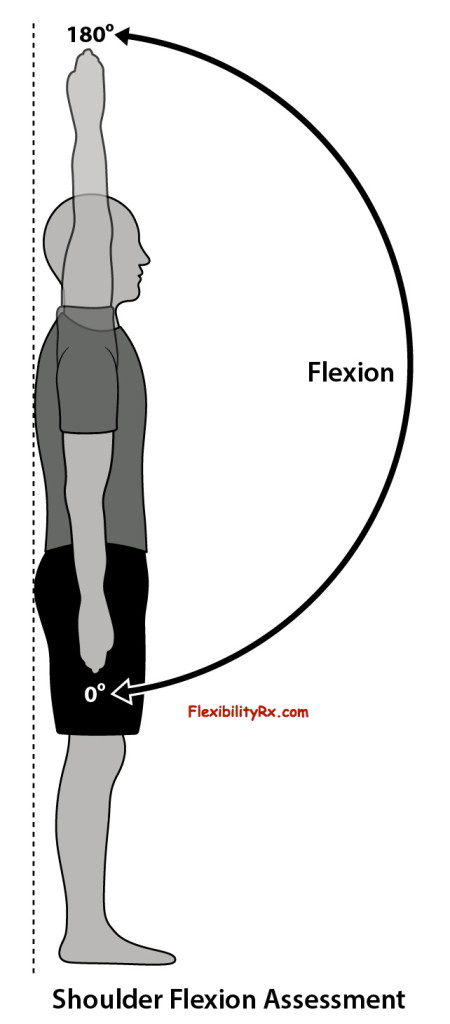
#8: Scapular Upward Rotation
Shoulder flexion range of motion is 180 degrees. The 180 degrees comes from sixty degrees of scapular upward rotation and 120 degrees of shoulder flexion. Even if an athlete has good thoracic extension and arm movement, if scapular stability is not present (dynamic control of upward rotation), then shoulder flexion will be limited.
The motor control needed for upward rotation is a balance between the upward rotators and downward rotators of the scapula.
The upward rotators are often weak (lower/upper trap, serratus anterior) and downward rotators are often overactive (pec-minor, rhomboid, levator scapula).
Restoring upward rotation is a combination of stretching the downward rotators and activating the upward rotators (forearm wall slides, half-kneeling face-pull).
Instructions: Perform the shoulder flexion assessment (test #7) away from the wall focusing on your initial range of motion. If shoulder flexion is limited, note the ability of the lower part your shoulder blade (scapula) to move away from the spine during your arm movement. If your shoulder rises and you feel tension in your neck during the movement your downward rotators may be overactive and upward rotators (lower trapezius for example) underactive.
#9: Hip Hinge Pattern
The hip hinge is a fundamental movement pattern that is the basis of picking an object off the floor as in a deadlift. Many athletic movements are variations of the hip hinge: shooting a free throw in basketball, the ready stance in wresting, and the hip-flexed position of a kettlebell swing or box jump.
Learning the hip hinge can improve the squat – which requires keeping your weight on your heels and pushing the hips back so you can squat below parallel. While the squat is a knee dominant movement, the hip hinge is a hip dominant movement that helps athletes learn to keep a neutral spine as the hips shift back.
Both the barbell good morning and single leg RDL are great movements to train once an athlete learns to keep a neutral spine by using a pvc or dowel.
Instructions: After taking a hip width stance, grab both ends of dowel, placing it flat along the length of the spine. The knees will remain slightly bent throughout the movement. Begin by driving the hips back, keeping a neutral spine, as the torso lowers. The hip and spine end up in a ‘V’ position not a ‘L’ position. End the movement once the angle between the hips and spine is a ‘V’.
Note your ability to keep a neutral spine (not flexing or extending the low-back) as the hips drive backward. To end the movement drive the hips forward as the torso raises.
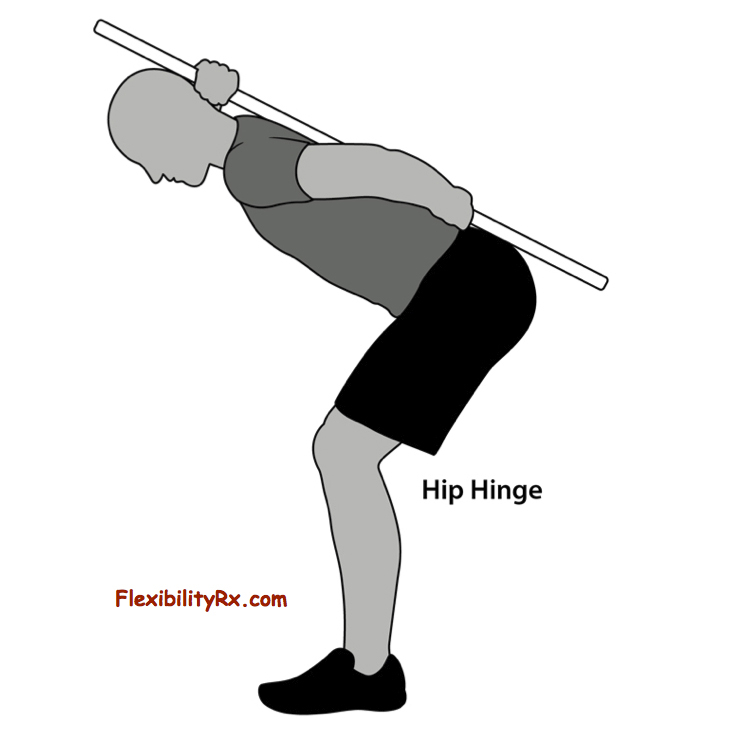
– Kevin Kula, “The Flexibility Coach” – Creator of FlexibilityRx™
Interpreting your Results
The FREE Guide, “Joint-by-Joint Approach to Flexibility & Stability Training” is downloadable by providing your email at the bottom of the page. Detailed exercises are provided to help you pass each test.
The guide will be available in a few days – you can send an email to Kevin@FlexibilityRx.com to receive a copy until the sign-up form is up and running.
